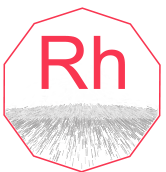Rhodium

Rhodium (Rh)
General Information
- Symbol: Rh
- Atomic Number: 45
- Atomic Weight: 102.90550 u
- Element Category: Transition metal
- Group: 9
- Period: 5
- Block: d-block
Physical Properties
- Appearance: Silvery-white metallic, highly reflective
- Density: 12.41 g/cm³
- Melting Point: 1964 °C (3567 °F)
- Boiling Point: 3695 °C (6683 °F)
- Phase at STP: Solid
- Electron Configuration: [Kr] 4d⁸ 5s¹
- Oxidation States: +3 (most common), +4, +2, +1, 0
Chemical Properties
- Reactivity: Resistant to corrosion and oxidation; does not easily react with most chemicals.
- Compounds: Forms compounds such as rhodium(III) chloride (RhCl₃), rhodium(III) oxide (Rh₂O₃), and various organometallic compounds like Wilkinson’s catalyst (RhCl(PPh₃)₃).
Uses and Applications
- Catalysts: Widely used as a catalyst in automotive catalytic converters to reduce harmful emissions, and in chemical reactions such as the hydrogenation of alkenes.
- Electronics: Used in electrical contacts and connectors due to its conductivity and resistance to wear.
- Jewelry: Used as a plating material to give a reflective white surface to gold and silver jewelry.
- Glass Manufacturing: Utilized in the production of specialty glass, including fiberglass.
- Chemistry: Employed in laboratory equipment and as a catalyst in organic synthesis.
Occurrence and Extraction
- Natural Occurrence: Found in ores with other platinum group metals, primarily in minerals like rhodite and sperrylite.
- Extraction: Extracted as a byproduct of platinum and nickel mining through a series of chemical processes including dissolution, precipitation, and purification.
Isotopes
- Stable Isotope: Rhodium-103
- Radioactive Isotopes: Several, including Rhodium-101 and Rhodium-102
Safety and Handling
- Hazards: Generally considered to be of low toxicity; however, rhodium compounds should be handled with care as they can be toxic.
- Precautions: Use appropriate protective equipment and handle in a well-ventilated area.
History
- Discovery: Discovered by William Hyde Wollaston in 1803.
- Name Origin: Derived from the Greek word “rhodon,” meaning rose, due to the rose-red color of its salts.
Additional Facts
- Crystal Structure: Face-centered cubic (fcc)
- Magnetic Properties: Paramagnetic
- Thermal Conductivity: High, about 150 W/m·K
- Electrical Resistivity: About 43.3 nΩ·m at room temperature
Summary
Rhodium is a transition metal known for its exceptional resistance to corrosion and oxidation, high reflectivity, and excellent catalytic properties. It is extensively used in automotive catalytic converters, electronics, jewelry, and glass manufacturing. Found primarily in ores with other platinum group metals, rhodium is extracted through complex chemical processes. Its stability and unique properties make it valuable across multiple industries.
What is the atomic number of Rhodium?
- 45
What is the symbol for Rhodium?
- Rh
What is the atomic weight of Rhodium?
- 102.90550 u
In which group of the periodic table is Rhodium found?
- Group 9
What period is Rhodium in?
- Period 5
What block does Rhodium belong to?
- d-block
What is the melting point of Rhodium?
- 1964 °C (3567 °F)
What is the boiling point of Rhodium?
- 3695 °C (6683 °F)
What is the density of Rhodium?
- 12.41 g/cm³
What is the electron configuration of Rhodium?
- [Kr] 4d⁸ 5s¹
What are the common oxidation states of Rhodium?
- +3, +4, +2, +1, 0
What is the appearance of Rhodium?
- Silvery-white metallic, highly reflective
Is Rhodium reactive with most chemicals?
- No, it is resistant to corrosion and oxidation
Name a compound of Rhodium.
- Rhodium(III) chloride (RhCl₃)
What is a common use of Rhodium in the automotive industry?
- As a catalyst in catalytic converters
How is Rhodium used in electronics?
- In electrical contacts and connectors
What role does Rhodium play in jewelry?
- Used as a plating material to give a reflective white surface
How is Rhodium used in glass manufacturing?
- In the production of specialty glass, including fiberglass
What is a major application of Rhodium in chemistry?
- As a catalyst in organic synthesis
Name a mineral that contains Rhodium.
- Rhodite
How is Rhodium extracted from ores?
- Through chemical processes including dissolution, precipitation, and purification
What is the most stable isotope of Rhodium?
- Rhodium-103
Name a radioactive isotope of Rhodium.
- Rhodium-101
What safety hazard is associated with Rhodium compounds?
- They can be toxic
Who discovered Rhodium?
- William Hyde Wollaston
Where does the name Rhodium come from?
- From the Greek word “rhodon,” meaning rose
What is the crystal structure of Rhodium?
- Face-centered cubic (fcc)
Is Rhodium paramagnetic or diamagnetic?
- Paramagnetic
What is the thermal conductivity of Rhodium?
- About 150 W/m·K
What is the electrical resistivity of Rhodium at room temperature?
- About 43.3 nΩ·m
What is the primary oxidation state of Rhodium?
- +3
Is Rhodium found as a free element in nature?
- No, it is found in ores with other platinum group metals
What is the common name of Rhodium(III) oxide?
- Rhodium sesquioxide
What is a major application of Wilkinson’s catalyst?
- Used in hydrogenation of alkenes
How does Rhodium improve electrical contacts?
- By providing durability and resistance to wear
What is the boiling point of Rhodium in Kelvin?
- 3968 K
What group does Rhodium belong to in the periodic table?
- Transition metals
What is the natural abundance of Rhodium-103?
- 100%
Can Rhodium be used in high-temperature applications?
- Yes, due to its high melting point
What is the key property that makes Rhodium valuable in catalysis?
- Its excellent resistance to corrosion and oxidation.






